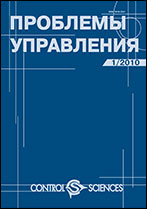|
This article is cited in 3 scientific papers (total in 3 papers)
Reviews
Methods of solving fuzzy systems of linear equations. Part 1. Fully systems
N. P. Demenkova, E. A. Mikrinba, I. A. Mochalova
a Bauman Moscow State Technical University
b S.P. Korolev Rocket and Space Corporation «Energia»
Abstract:
It is noted that fuzzy systems of linear equations (FSLE) arise when solving fuzzy initial problems, fuzzy partial differential equations of the first order; when processing hybrid data in stochastic systems by the method of least squares or of maximum likelihood estimation; when using the fuzzy Laplace transform to solve fuzzy differential equations of high order; when using the approximate methods of solving fuzzy integral Fredholm-Volterra equations of the 2nd kind; when fuzzy interpolation and fuzzy splines are applied to data processing; when solving fuzzy optimal control problems. The basic methods of solving complete FSLE are considered: inverse matrix, span and ST decomposition, in which fuzzy elements have triangular membership function; cuts, in which membership functions of fuzzy elements are not necessarily triangular; crisp solutions, in which left and right branches of the membership function of fuzzy elements are in the polynomial form. The application of the methods is illustrated by computational examples. Using the least squares method for the model with fuzzy basis functions and the method of fuzzy Gram-Schmidt orthogonalization, the problems are formulated and solved of fuzzy estimation, in which complete FSLE appear. To illustrate the solution of these problems, two fuzzy basic functions are considered: a fuzzy unit and a fuzzy linear dependence.
Keywords:
complete fuzzy system of linear equations, fuzzy methods of solving complete fuzzy systems, fuzzy estimation, fuzzy orthogonalization.
Received: 27.12.2018
Revised: 28.02.2019
Accepted: 04.04.2019
Citation:
N. P. Demenkov, E. A. Mikrin, I. A. Mochalov, “Methods of solving fuzzy systems of linear equations. Part 1. Fully systems”, Probl. Upr., 2019, no. 4, 3–14
Linking options:
https://www.mathnet.ru/eng/pu1145 https://www.mathnet.ru/eng/pu/v4/p3
|

|




 Contact us:
Contact us: Terms of Use
Terms of Use
 Registration to the website
Registration to the website Logotypes
Logotypes







 Citation in format
Citation in format 
